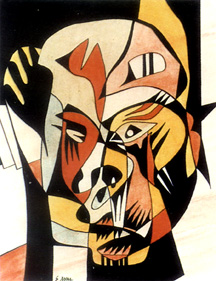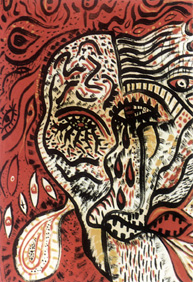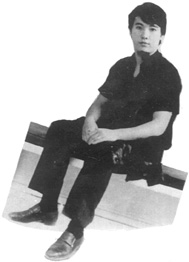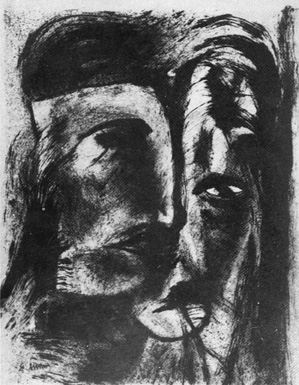"After having walked through many shadowy corridors, many steep staircases, one arrives at the territory occupied by Novikoff-his subconscience-which is unrelentingly guarded by a huge executioner with a drawn ax. A thick door gives access to the cell. Maybe even to the torture rooms."
 "Cold-Hot"(oil-painting 28×35 cms)
"Cold-Hot"(oil-painting 28×35 cms)
 "Traveller"(water colour 28×35 cms)
"Traveller"(water colour 28×35 cms)
When the first Portuguese edition of "Revista de Cultura" was published, several plastic art exhibitions were being inaugurated, some of them very interesting.
As an usual practice in Macau, the government is the main responsible body-through its proper institutions-for the most and more important exhibitions.
When an exhibition is undeniably interesting and, furthermore, breaks the traditional hegemony of the government, then such an exhibition must be cherished in a very special way. It is the case of Novikoff, a young Macanese painter who exhibited 35 of his drawings and paintings which he named "Related Matters". (1) This title says nothing about the exhibited works which are a sequence of faces, almost an ethnographic album of African masks, maybe a reunion of old sorcerers dancing around the fire with their masks. It is certainly the influence Novikoff got from Africa, something he cannot deny and must accept by necessity.
We see flames, fire arrows that the artist throws not from his mouth but from his hand in every drawing and painting, as if he was spreading the geomantic, appeasing ashes on the every day soil he avidly chews. The faces painted by the artist are psychic X-rays of himself resulting from his labyrinthic personality. He cannot exhibit these faces in daily life, because they are not accepted by the consumer society, neither are they allowed to be shown publicly; what people accept are those polished, alabaster masks or the standardized, every-day, common faces. So, the artist can be himself only when he looks at himself on the canvas or on the paper.
In the catalogue, António Andrade describes in a lively and brief way, how Novikoff mixes "in the labyrinth of an inner life (...) so different matters such as iconic and literary symbols assembled together with no erudition purpose". And these symbols are the mask, the "element that includes in itself a devoted connection with its roots and such a pressing grasp on life that it becomes ever present".
What Sales Novikoff proposes in his painting is violently disturbing and nobody can remain indifferent to that idea, because that is the truth. The artist does not hide himself behind the curtain of erudition, because he lacks it; neither does he follow this or that cultural trend, because he is independent. In this sense we can say that Novikoff is a naïf.
I think I can transcribe now what I have written 3 years ago about this artist and his work, because both remain coherently unchanged, although that text was less "african" than the present article.
So: "It is useless to characterize, to define according to the artistic trends, to classify the work of Novikoff: it is not worthwhile to search in his work the expressionist research of Eduard Munch, the colour attempt, sometimes fauvist, the Picasso distortions or the Afro and Latin-American influences.
It seems important to look, in the paintings of the artist, for the main aspects of his daily life, for the vast empire of his subconscience that he, Novikoff, cannot master or tyrannize. Tyrannize is the right word, to tyrannize the little devils who occupy his mind by banning violence. Violence is the key-word for Novikoff: "My paintings are very violent and so I don't want to get very violent titles", "violence is important in life". He tries to ban violence, peacefully. His violence is neither delinquency nor demonism, but something which flesh is heir to.
After having gone through many shadowy corridors, many steep staircases, one arrives at the territory occupied by Novikoff-his subconscience-which is unrelentingly guarded by a huge executioner with a drawn ax. A thick door gives access to the cells.
Maybe even to the torture rooms. In this forum of uncontrolled forces, there are terrors, traumas, victories, frustrations, experiences, ghosts, memories, primitive impulses, pre-historical animals, life and death, births and joys. The executioner stays, strict and intolerant.
Not very far from this occupied territory, there is another, but which is free. There, the ideas, the imagination and the will walk together dressed in blue.
Novikoff tries to penetrate those two worlds, to control those energies. Could he succeed or not? It is exactly the canvas or the passbook that enables him to go through these "territories", to go through his own nature.

But how to get rid of it if the world around us is violent? Just with the painter's brush that exorcizes this evil. This violence is set free by the despair of the artist who cannot repress it inside himself. The inner violence collides with the surrounding violence and in a rebounce it comes back to the white surface of the canvas where it is captured forever by the artist in his drawings and paintings.
"(...) imagining everything that could possibly happen around it (nature), interior and exterior (...)" "(...) I grew up but I am still the same dreamer who believes in those relations. For me, to paint is to prove the existence of all those relations. For me, all existence comes from the non-existent and vice-versa ".
I think that, at present, the most important aspects in Novikoff are not the africanism, the primitivism, the psychadelic visions of the 60's and 70's, the influence of Münch, Emil Nolde and Otto Mueller, the fight of the Blaue Reiter, etc. It is enough to consider him as an initiating artist. We must plunge into his world, a world that he creates everyday and that exists between the occupied country and the blue kingdom of freedom ". Three years later, Novikoff amazes us not by the novelty but by the continuity and coherence of his works. An innate coherence to paint what he wishes to paint and what he really needs to paint. In the Macau desert of plastic arts, the sorcery of his work is truly refreshing.
Translated by Lúcia Pombeiro

"Encounter" (China ink on paper, 51×38.5 cms)
(1)In this case, the exhibition must be specially cherished. because the sale of his works went to the Polioplus, a campaign promoted worldwide by the Rotary International to vaccinate 50 million new-born babies against polio, measles, diphteria, tuberculosis, tetanus and pertussis for 5 consecutive years. The exhibition in Macau was sponsored by the Rotary Amagao.
start p. 74
end p.